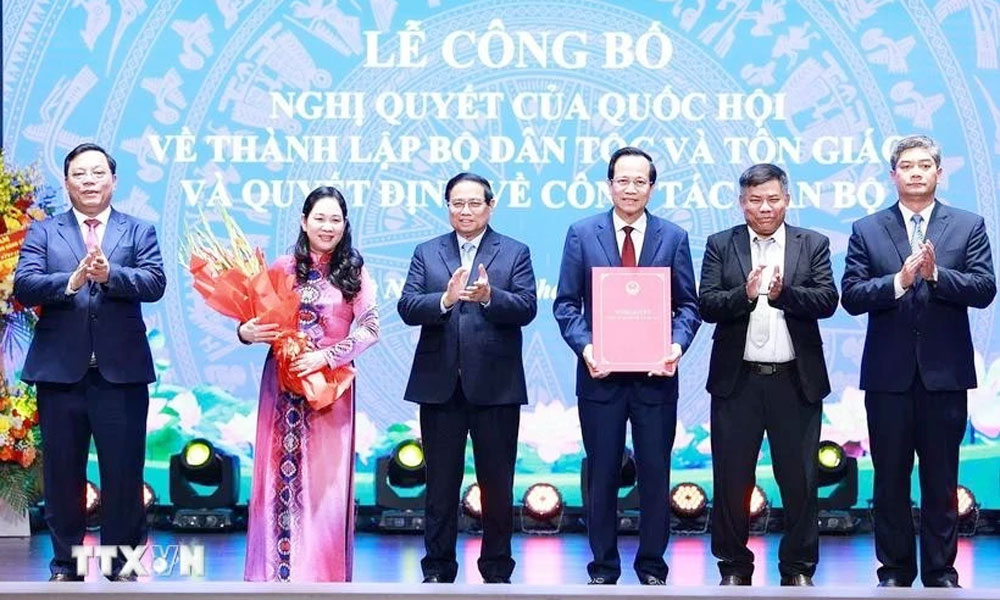National Assembly’s resolution on reorganisation of provincial-level administrative units: A historic decision
On the morning of June 12, the National Assembly voted to approve a resolution on the reorganisation of provincial-level administrative units, reducing the number of provinces and cities nationwide from 63 to 34. The resolution took effect immediately upon approval.
This is the first time in nearly half a century that Viet Nam has had such a low number of provincial-level administrative units. This decision is not merely an administrative organisational matter but marks a profound reform milestone, signalling a strong shift in national governance thinking in the era of integration and sustainable development.
 |
|
Lawmakers at the 9th session of the 15th National Assembly. |
Since the country’s reunification in 1975, Viet Nam has adjusted its administrative map several times. However, most previous adjustments involved splitting units to better serve local management needs amid shortages in many areas.
Meanwhile, the 2025 reorganisation is a deep “strategic restructuring” based not only on geographical factors but also considering modern criteria such as regional connectivity, economic efficiency, urban development potential, infrastructure systems, socio-cultural aspects, and especially the national development vision.
The reduction from 63 to 34 provinces and cities is the result of thorough and systematic consideration over many years. It is a bold, far-sighted choice by the Party and state aimed at streamlining the apparatus, saving the budget, strengthening decentralisation to localities, while also creating conditions for new growth poles with scale and competitiveness at regional and international levels.
Unlike previous piecemeal mergers, this restructuring is comprehensive and synchronised.
According to the government’s report, it is estimated that about 447,600 officials, civil servants, and public employees are affected by the reorganisation.
The reassignment of personnel, handling of employee layoffs, and rearrangement of administrative offices (around 4,200 offices will no longer be in use) require specific, coordinated plans.
If well implemented, this will represent significant budget savings, reduce overlapping functions, and increase efficiency and flexibility in the operation of the public administration.
The merger also serves as an important test of leadership capacity at the grassroots level. Selecting key officials at commune and ward levels — those who understand the law and are closely connected to practical realities — will determine the success or failure of this reform.
The administrative reorganisation is more than just an organisational challenge; it is an opportunity to upgrade the state governance model to meet the demands of the digital age.
The government has clearly stated: administrative reform must be linked with digital transformation, artificial intelligence (AI), and transparency in public service activities.
As the scale of provinces and cities expands, with increased population and area, the application of technology in public service delivery is inevitable to ensure efficiency and broad accessibility.
This also lays the groundwork for promoting decentralisation and delegation of authority, a core element of institutional reform. When local governments are granted more power but also bear greater responsibility, the system will operate transparently, linking accountability with specific authority.
This administrative reorganisation also provides an opportunity to standardise the civil servant and public employee workforce towards a leaner, higher-quality model.
This will eliminate the longstanding problem of “bureaucratic bloat” with low efficiency that has existed within the state management system for many years.
A major decision of this scale inevitably raises concerns, especially in localities subject to mergers. National Assembly Chairman Tran Thanh Man stated that this is “a crucial matter thoroughly discussed by the Central Committee and the Politburo.” He called on localities and citizens to “greatly share and sympathise for the nation’s greater goal.”
It is also important to emphasise that social consensus is the foundation of all reforms. Collecting grassroots opinions, clearly explaining objectives, ensuring transparency in procedures, and safeguarding the legitimate rights of the people, particularly in accessing public services, are essential conditions for the smooth implementation of the reorganisation process.
A positive sign is that, to date, survey data show strong support from all levels of government and the public, creating united strength and momentum for change, as major policies are rooted in practical realities and enjoy the people’s unanimous agreement.
It can be affirmed that the 2025 administrative unit merger is one of the most revolutionary decisions regarding state apparatus organisation in the new era.
It is also regarded as a breakthrough in development thinking: daring to abandon outdated models to establish a modern, streamlined, and more effective governance order. Above all, it prioritises the national and ethnic interests and continues steadfastly on the path of reform with decisive, scientific, and humane actions.
 Bắc giang
Bắc giang













Reader's comments (0)